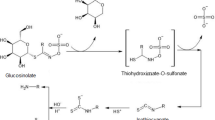Abstract
Residue concentrations of the sprout suppressant chlorpropham (or CIPC) were determined in raw and cooked potatoes and processed potato products, 48 h after CIPC aerosol treatment and after 30 days of subsequent storage at 4 or 12 °C. In the raw (uncooked) tuber, 48 h after CIPC treatment, the CIPC residue in the peel was 4.7 mg kg-1, while in the peeled tuber it was 0.1 mg kg-1. Boiling resulted in a decrease in residue concentration in the peel, but no significant differences in the residue concentration of the peeled tuber were observed. Pressure cooking resulted in a significantly increased residue concentration in the peel, but no significant change in the peeled tuber, whereas microwave cooking also did not increase the residue concentration in the peel significantly compared with that in raw tubers. Also the trend towards increases in residue concentration in microwave-cooked peeled tubers was not significant. The CIPC residue concentration detected in peeled tubers was 0.4–0.7 mg kg-1 after boiling, 0.4–1.5 mg kg-1 after pressure cooking and 0.4–3.8 mg kg-1 after microwave cooking. The highest values were always found for tubers stored for 30 days at 4 °C. Processed products such as crisps, French fries, dehydrated sliced potatoes and starch contained different concentrations of CIPC residue, which was also detected in the cooking water and frying oil. The highest residue concentrations detected were 0.7, 4.7, 1.3 and 0.2 mg kg-1 in crisps, French fries, dehydrated sliced potatoes and starch, respectively. The highest CIPC residue concentration observed in raw potatoes was much lower than the maximum residue level of 10 mg kg-1 prescribed by the European Union.

Similar content being viewed by others
Abbreviations
- CIPC:
-
Isopropyl N-(3-chlorophenyl) carbamate
- HPLC:
-
High-performance liquid chromatography
- MRL:
-
Maximum residue level
References
Anonymous (2002) CIPC suppliers prepared for residue limit. Potato Rev (Nov): 20–23
Boyd IMG, Dalziel J, Duncan HJ (1982) Studies on potato sprout suppressants. 5. The effect of chlorpropham contamination on the performance of seed potatoes. Potato Res 25:51–57
Central Potato Research Institute (1999) Package of practices for ware and seed potato production in north-western hills. Extension Bulletin 15. Central Potato Research Institute, Shimla
Conte E, Imbroglini G, Bertolini P, Camoni I (1995) Presence of sprout inhibitor residues in potatoes in relation to application techniques. J Agric Food Chem 43:2985–2987
Corsini D, Stalknecht G, Sparks W (1979) Changes in chlorpropham residues in stored potatoes. Am Potato J 56:43–50
Dalziel J, Duncan HJ (1980) Studies on potato sprout suppressants. 4: The distribution of tecnazene in potato tubers and the effect of processing on residue levels. Potato Res 23:405–411
EPA (1996) Registration eligibility decision. Environmental Protection Agency (EPA)-738-R-96–023
Ezekiel R, Mehta A, Singh B, Kumar D, Kumar NR, Paul V, Das M (2005) CIPC (isopropyl N-(3-chlorophenyl) carbamate) for sprout suppression in potatoes during storage. Technical Bulletin 69. Central Potato Research Institute, Shimla
Hasegawa Y, Tonogai Y, Nakamura Y, Ito Y (1992) Residue concentrations of dichlorvos, chlorpropham and pyrethrins in post harvest-treated potatoes during storage or processing into starch. J Agric Food Chem 40:1240–1244
Kleinkopf GE, Brandt TL, Frazier MJ, Moller G (1997) CIPC residues on stored Russet Burbank potatoes: 1. Maximum label application. Am Potato J 74:107–117
Kleinkopf GE, Oberg NA, Olsen NL (2003) Sprout inhibition in storage: current status, new chemistries and natural compounds. Am Potato J 80:317–327
Koniger M, Wallnofer PR (1998) Behaviour of growth inhibitors propham (IPC) and chlorpropham (CIPC) in potatoes after different cooking methods. Dtsch Lebensm Rundsch 94:229–231
Lentza-Rizos C, Balokas A (2001) Residue concentrations of chlorpropham in individual tubers and composite samples of post harvest-treated potatoes. J Agric Food Chem 49:710–714
Lewis DJ, Thorpe SA, Reynolds SL (1996) The carry-through of residues of thiabendazole, tecnazene and chlorpropham from potatoes following manufacture into potato crisps and jacket potato crisps. Food Addit Contam 13:221–229
Mondy NI, Sharada D, Munshi CB, Wurm CM (1992) Effect of storage time, temperature and cooking on isopropyl N-(3-chlorophenyl) carbamate concentrations in potatoes. J Agric Food Chem 40:197–199
Nagami H (1997) Residues of maleic hydrazide and chlorpropham in potato chips. Bull Environ Contam Toxicol 58:764–768
Ritchie W, Boyd IMG, Duncan HJ (1983) A method for the determination of chlorpropham residues in crisps and crisp frying oil. Potato Res 26:73–77
Singh B, Kaul HN (1999) Analysis of chlorpropham (CIPC) residues in stored potato tubers by gas chromatography. Indian J Plant Physiol 4:121–124
Van Vliet WF, Sparenberg H (1970) The treatment of potato tubers with sprout inhibitors. Potato Res 13:223–227
Verma SC (1991) Potato processing in India. Technical Bulletin 34. Central Potato Research Institute, Shimla
WHO/FAO (1964) Evaluation of the toxicity of pesticide residues in foods; report of the joint meeting of the FAO committee on pesticides in agriculture and the WHO expert committee on pesticide residues. FAO meeting report PL/1963/13: WHO Food Add./23. FAO, Rome
Wilson AM, Bushway AA, Bushway RJ (1981) Residue analysis of isopropyl N-(3-chlorophenyl) carbamate in fruits and vegetables using high-performance liquid chromatography. J Agric Food Chem 29:746–749
Acknowledgements
The authors are grateful to the Director, Central Potato Research Institute, Shimla for facilities and to Suresh Kumar for technical assistance.
Author information
Authors and Affiliations
Corresponding author
Rights and permissions
About this article
Cite this article
Ezekiel, R., Singh, B. Effect of Cooking and Processing on CIPC Residue Concentrations in Potatoes and Processed Potato Products. Potato Res. 50, 175–184 (2007). https://doi.org/10.1007/s11540-008-9043-z
Received:
Accepted:
Published:
Issue Date:
DOI: https://doi.org/10.1007/s11540-008-9043-z




